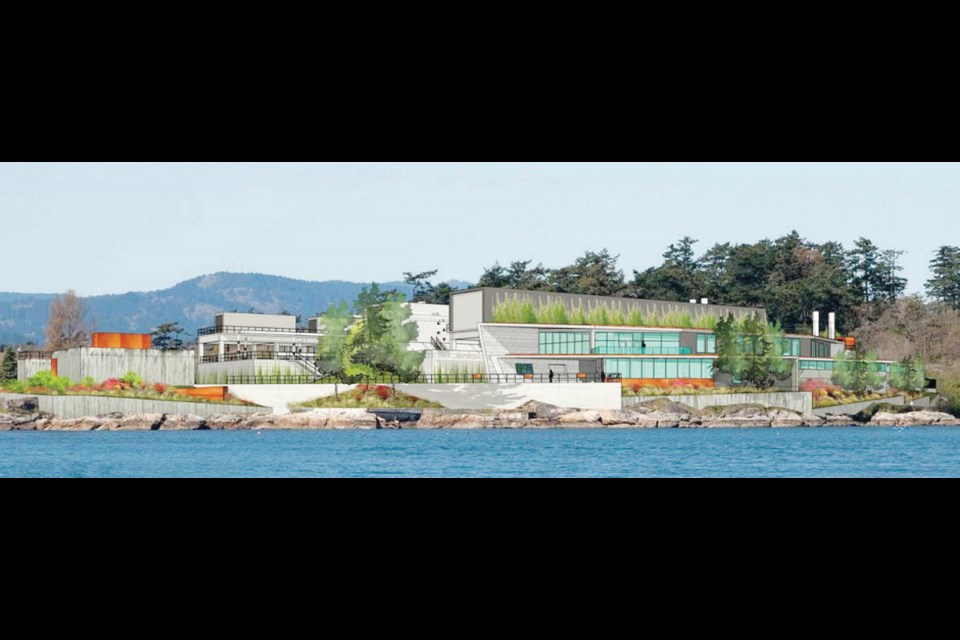With construction starting in weeks, officials shepherding Greater Victoria’s sewage treatment project are trying to assure area residents that everything possible will be done to reduce noise, dust and odours while it’s being built — and once it’s operating.
Capital Regional District directors approved a funding agreement with the province for $248 million of the $765-million project this week. They also heard from James Bay residents worried about more than a year of construction.
Horizontal drilling will be done to accommodate a sewage pipe from Ogden Point to McLoughlin Point, where a new treatment plant is to be built.
“That drilling will take place 50 metres from residents,” James Bay resident Wayne Shillington said.
“Residents, including elderly and young children, will be exposed to drilling 12 hours a day during the week and nine hours on Saturday. That’s 70 hours per week for a year.”
While noise limits have not been set, noise levels of 80 dBA (A-weighted decibels) have been discussed, he said.
“What does 80 dBA sound like? It’s your garburator noise as you stand by the sink. Think about that. Twelve hours a day, every day.”
Shillington said the city’s noise bylaw, which was designed to deal with transient noise such as passing motorcycles, is not an acceptable standard. World Health Organization guidelines for continuous noise deem 55 dBA acceptable, and a level of 60 dBA should be set for the sewage construction, he told the CRD core area liquid-waste committee.
Darrel Woods called for adherence to best practices for noise and odour once the plant is operational.
“In my opinion, the most important amenity for this community is a well-functioning system, with mitigation of significant construction and longer-term operating impacts,” he said.
Jane Bird, project board director, told directors the contractor is in the final stage of developing a noise-reduction plan. Area residents and other stakeholders, such as school officials, will be consulted and have an opportunity to review the plan, she said.
“We are very, very alive to the concern. We’re alive to the concern that the [existing] noise bylaw will not do it, and we are working on a solution we hope will be acceptable.”
Directors agreed that the project team should continue to consult with the James Bay Neighbourhood Association, Fairfield/ Gonzales Community Association and residents on construction-mitigation measures, design of a multi-use trail planned along Dallas Road and identification of amenities for James Bay.
Saanich Mayor Richard Atwell also raised concerns about the project.
He wondered about the CRD’s “apparent rush” to sign the provincial funding agreement when the method and costs for processing sewage sludge at the Hartland landfill have not been determined.
How sewage-treatment residuals (sludge) will be processed at Hartland is being determined as the CRD investigates a means called Integrated Resource Management.
That investigation is looking at technologies that could process both sewage sludge and kitchen scraps together.
Atwell said that with a provincial election approaching, the CRD shouldn’t limit itself to capped funding from the province — especially as it hasn’t been determined how much residuals processing will cost.
“I think the prescient issue is the fact that we have an undefined portion of the [sewage treatment] project and a funding limit — and we don’t know how we’re going to pay for that,” Atwell said.
“We should have at least a memorandum of understanding or some kind of certainty around it before we enter into this agreement,” he said.
Bird said meeting the federal government’s mandated 2020 deadline for sewage treatment means construction of the plant has to start next month. Signed funding agreements have to be in place to make that happen.
“Frankly, it would be nice if the timing were different, but it’s no more complicated than that. If we’re not in the ground in April, we will not meet the 2020 deadline. And even at that, it’s a very ambitious schedule,” Bird said.
Harbour Resource Partners will build the treatment plant, an undersea force main between Ogden and McLoughlin points, and a marine outfall off McLoughlin. Force mains, needed when gravity flow is not sufficient to move sewage through a line, involve the use of pumps or compressors.
Construction is anticipated to begin at both McLoughlin and Ogden points next month, with a completion date of Nov. 20, 2020.
The projected cost is $765 million. The treatment plant at McLoughlin Point is budgeted at $385 million. Residuals treatment at Hartland landfill is budgeted at $189 million and conveyancing — including pipelines and pumps — at $192 million.
Local taxpayers will be responsible for $306 million, while $459 million will come from the federal and provincial governments.



